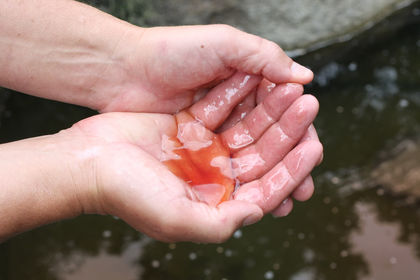Typhoid Fever

Typhoid fever is a bacterial infection that is common in many parts of the world. It is spread by contaminated water and food and primarily affects the digestive system.
KEYWORDS
for searching the Internet and other reference sources
Foodborne diseases
Salmonella typhi
Waterborne diseases
What Is Typhoid?
In many developing countries, typhoid fever is a major problem. It is estimated to cause 16 million illnesses and more than half a million deaths each year worldwide. It is especially common in parts of Asia, Africa, and South America where pure water is not readily available and sewage treatment is limited. In many countries, children are the most likely to get typhoid.
Typhoid used to be a serious problem in the United States as well. Early in the twentieth century, before clean water supplies and sewage systems to dispose of human waste were widely available, it caused about 35,000 illnesses each year. Technological advancements in sewage and water treatment have made typhoid fever rare in industrialized countries. Only about 400 cases are reported each year in the United States. Most of them are acquired while traveling abroad.
What Causes Typhoid Fever?
Typhoid fever is caused by a bacterium called Salmonella typhi. It is related to the salmonella bacteria that cause food poisoning, but they are not exactly the same.
The U.S. and the World
About 16 million cases of typhoid fever occur each year worldwide, and more than 600,000 people die from it.
The disease is common in many underdeveloped nations of the world, especially parts of Asia and in South America with unsanitary water and food preparation. The situation is made more difficult because the disease is showing resistance to some of the traditional antibiotics used to treat those who are infected.
About 400 cases a year are reported in the United States, but about 70 percent of them involve people who had traveled overseas.
In 1998-1999,13 people in Florida contracted typhoid fever when they drank shakes made with a frozen tropical fruit containing Salmonellityphi.
Typhoid fever is suspected in the deaths of such famous people as Alexander the Great, Wilbur Wright of the Wright Brothers, and poet Gerard Manley Hopkins.
Typhoid Mary
Some people, called carriers, can be infected with Salmonella typhi but not develop typhoid fever. If they prepare food for others, however, they may contaminate the food they handle and pass the bacteria on to other people who eat it and then may get sick.
The most famous typhoid carrier was Mary Mallon, also known as Typhoid Mary, who worked as a cook in homes in New York and New Jersey in the early 1900s. Fifty-one cases of typhoid fever resulting in three deaths were traced to her. Mallon never was sick herself, however, and she never accepted that she had infected anyone else.
Against her will, the authorities confined Mallon to a hospital on North Brother Island in New Yorks East River. Three years later, in 1910, they released her on condition that she never work as a cook again. But in 1915, typhoid struck a maternity hospital in Manhattan, and it turned out that Mallon had cooked there. She spent the rest of her life, 23 years, as a captive on North Brother Island.
Salmonella typhi bacteria are present in the solid wastes (stool) of infected people, including some "healthy carriers" who have no symptoms of illness. The bacteria can spread if human waste gets into water that is used for drinking, irrigating crops, or washing food. Typhoid also occasionally is transmitted through an infected person who is working in food preparation. Once swallowed, the bacteria move from the digestive tract into the bloodstream and then to the liver, spleen, gall bladder, and lymph nodes.
What Happens When People Have Typhoid Fever?
Symptoms
The symptoms of typhoid fever come on gradually. At first, people may get a headache, stomachache, and constipation * . They develop a fever and lose their appetite. In some cases, they may get rose spots, a rash mostly on the chest and abdomen. As symptoms worsen, the fever may rise as high as 103 to 104 degrees Fahrenheit. People often develop bloody diarrhea, become dehydrated (lose fluids faster than they are replaced), and start acting confused or disoriented. In severe cases, people may go into a coma, a state of deep unconsciousness, and die.
Diagnosis and Treatment
A blood or urine test usually can detect the presence of the bacterium that causes typhoid fever. Antibiotic drugs that fight the bacterial infection can make the illness shorter and milder and prevent complications. Fluids may be given as well to counter the effects of diarrhea. Severe infections can lead to a perforation (hole) in the intestine that requires surgery to repair.
How Is Typhoid Fever Prevented?
Clean water supplies and effective waste disposal systems are the best ways of preventing typhoid, but these are lacking in many countries. A vaccine is available that is about 70 percent effective for several years.
Travelers to countries where typhoid fever is common should drink only boiled or bottled water. They should eat only food that has been properly cooked or fruit that they peel themselves and that has not been washed with tap water. The U.S. Centers for Disease Control and Prevention sums up advice for travelers this way: "Boil it, cook it, peel it, or forget it."
* constipation is the sluggish movement of the bowels, usually resulting in infrequent hard stools.
Resources
U.S. Centers for Disease Control and Prevention (CDC), 1600 Clifton Road
N.E., Atlanta, GA 30333. CDC posts a fact sheet about typhoid fever at
its website.
http://www.cdc.gov/ncidod/dbmd/diseaseinfo/typhoidfever_g.htm
World Health Organization (WHO), Avenue Appia 20, 1211 Geneva 27,
Switzerland. WHO's website posts fact sheets about typhoid fever
and other vaccine preventable diseases at its website.
http://www.who.org/home/map_ht.html